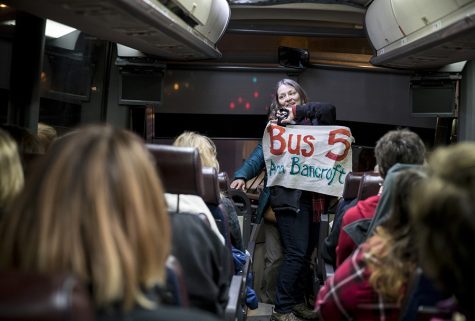#Imwithher
Why women dislike Trump
September 21, 2017
The 2016 Presidential Election was one of the most controversial to date. Two candidates that could not be more different fought a brutal fight that ended in an astonishing outcome; Donald Trump was sworn in as the 45th President of the United States.
What was most baffling about this election was the result. Hillary Clinton had won the popular vote with 66 million votes, approximately 3 million more than Trump, who had 63 million. However, Trump still came out on top.

Deborah Capouch holds up the bus sign that included its name, Anne Bancroft, before it hit the road for the Woman’s March on Washington early Friday morning, Jan. 20, 2016, in Minneapolis, Minn. The eight buses chartered from Minnesota were all named after prominent Minnesota women. (Renee Jones Schneider/Minneapolis Star Tribune/TNS)
According to The New York Times exit polls, 41 percent of men and 54 percent of women voted for Hillary, a 14 percent net difference. Exit polls show that of college-educated women, 95 percent of black women voted for Hillary, followed by 76 percent non-white, 65 percent Latino, and 51 percent white. These results, as compared to Trump’s, who managed to garner only 6 percent of the black votes, indicate the overwhelming female support of Hillary.
So why do women dislike Trump so much?
The 2016 election recorded one of the largest gender gaps in voting since 1952, coming in at 26.5 point difference. Such a division is not that hard to understand, a Clinton victory would have meant a woman in the oval office. This unprecedented event of US history, would have, once described by Clinton, “shatter the hardest, highest glass ceiling.”
Women’s dislike toward Trump might have to do with the long history of controversial and sexist comments that came to light on the election trail, such as the Access Hollywood tape. Lewd comments describing sexual actions toward a co-star of Trump made millions of American women feel violated and disgusted by Trump’s words. “I’m saddened that these comments still exist in our society at all. When I heard the comments yesterday, it was disappointing to hear such objectification of women,” Nancy O’Dell, the subject of the tape, said. “The conversation needs to change because no female, no person, should be the subject of such crass comments, whether or not cameras are rolling. Everyone deserves respect no matter the setting or gender.”
Women nationally called on Hillary, asking what they should tell their daughter about how the future president to be treats women. “To all the little girls watching, never doubt that you are valuable and powerful and deserving of every chance and opportunity in the world,” Clinton said. This served as a rallying point for bringing more female supporters.
2017 didn’t seem to improve Trump’s status among women. Following Trump’s hesitancy to condemn white supremacists in August, his approval rating fell to 34 percent, his lowest rating yet.
Perhaps the largest demonstration of the female resistance of the Trump administration occurred on January 21, 2017. The Women’s March on Washington united women nationally, becoming the largest coordinated protest in US history. The protest drew between 440,000 and 500,000 people and countless celebrities, all encouraging civilians to take action by donating or running for office. “Once it happens in a generation that a spirit of resistance is awakened. This is one of those moments.,” said Rabbi Sharon Brous, celebrity rabbi and guest speaker at the march. “Our children will one day ask us ‘where were you when our country was thrust into a lion’s den of demagoguery and division.”
The march addressed social injustice and highlighted the need for women’s rights reforms, such as reproductive rights and equal pay. Actress Scarlett Johansson spoke at the rally, showing her support of Planned Parenthood and how they once helped her. “I feel that in this current political climate, it is vital that we make it our mission to get really, really personal,” Johansson said. “President Trump, I did not vote for you. I want to be able to support you. But first I ask that you support me. Support my sister. Support my best friend and all our girlfriends.” She continued to speak of how her daughter “may not potentially have the right to make choices for her body that [Trump’s] daughter Ivanka has been privileged to have.”
Subsequent speakers followed with similar remarks. “The president is not America. His cabinet is not America. Congress is not America. We are America, and we are here to stay,” America Ferrera said.
On March 8, the American economy stood still. Half of the driving force behind the economy, women, didn’t go into work. Called “A Day Without a Woman,” women took the day off work, highlighting the importance of women in the workforce. Two million women filled the streets of Washington, protesting the economic injustices toward women, like lower wages and discrimination. Protests continue to occur, both online and in person. Small anti-Trump protests have sprung up nationally, and even globally, since Trump’s inauguration on January 20, 2017.
Despite all of Trump’s sexist comments and misogynistic actions, women continue to fight for equality and rights reforms. Women’s dislike toward Trump continues to fuel the fire of equality.















Aankit Pokhrel • Sep 22, 2017 at 4:12 pm
By the logic that women hate Donald trump because he said some things years ago about a lady, women should also hate on Hillary because of the fact that one of her cases was against a raped 12 year old. There are tapes of her talking about the case with the aquitted man and laughing. And also can you guys list you sources